Sustainable Fund Flows Shine Bright in a Dismal Third Quarter for U.S. Funds
This is a sharp contrast to the outflows of their nonsustainable peers.

U.S. sustainable fund flows snuck back into positive territory, as sustainable funds netted a modest $459 million during 2022′s third quarter. This comes on the heels of the first quarter of outflows in more than five years, weighed down by fears of recession, inflation, rising interest rates, and a global energy crisis.
Again, Sustainable Funds Fared Better Than Nonsustainable Peers
Though far from the all-time record $21.6 billion intake in 2021′s first quarter, flows into sustainable funds returned to positive territory in 2022′s third quarter. This was a notable departure from the total universe of U.S. open-end funds and exchange-traded funds, which bled $86 billion during the quarter.
Together with market depreciation, tepid demand for sustainable funds drove assets in these funds to $272 billion, their lowest point since the first quarter of 2021. Still, the U.S. sustainable funds landscape sustained a higher organic growth rate than the total U.S. fund universe. Calculated as net flows as a percentage of total assets at the start of a period, the OGR puts the magnitude of fund flows into perspective.

The continued growth of U.S. sustainable funds even during a period of poor performance could signal that investor demand for sustainable funds is more “sticky” than broader U.S. demand. On a quarterly basis, the U.S. sustainable funds market remained quasi-stable during the third quarter, growing by only 0.16%. By comparison, the total U.S. fund universe shrunk by 0.38%. So far this year, sustainable funds grew by 2.6%, while the broader universe shrunk by 0.71%.
Solar Energy Lit Up the Room
Sustainable index-based funds bounced back into positive territory, netting $1.5 billion during the period. This is a brighter picture than their second-quarter outflows but still well below their average quarterly intake of $8 billion over the past three years.
Clean energy/tech funds, which investors fled in the second quarter, were among the top flow-getters in 2022′s third quarter. For example, Invesco Solar ETF, which shed $190 million during the second quarter, more than made up its losses with $223 million in inflows during the third quarter. Earlier this year, renewable energy funds were pummeled by all-time record-high gasoline prices in the United States, and although the volatility in energy markets continues, inflows indicate investor optimism for these funds.
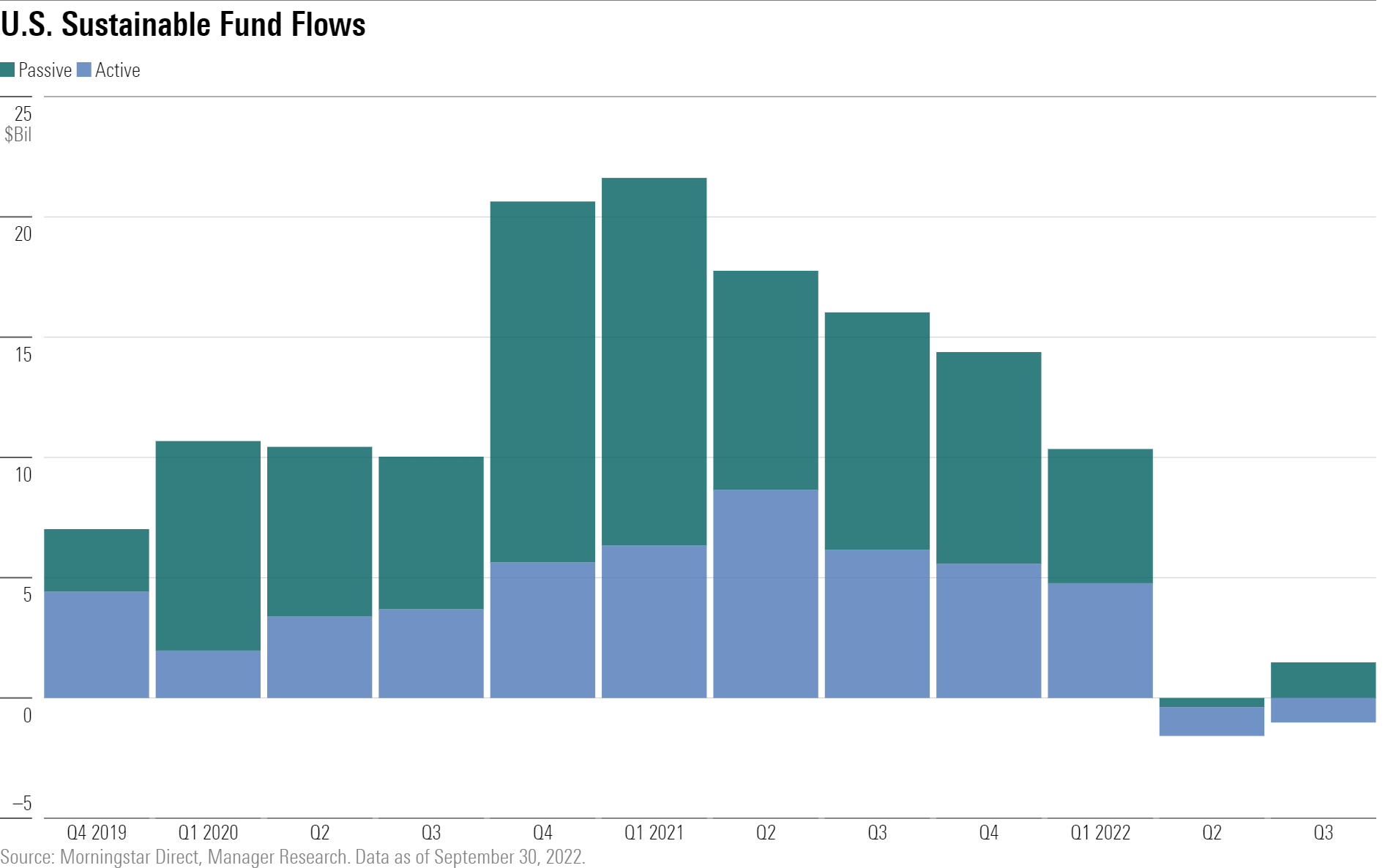
Investor demand for sustainable passive funds offset withdrawals from sustainable active funds, which lost more than $1 billion during the third quarter. Actively managed sustainable funds have endured a rough 2022, suffering outflows in four out of nine months so far. However, this pales in comparison to nonsustainable active funds, which have lost roughly $67 billion each month (on average) so far in 2022.
Are Investors Buying the Dip? Sustainable Fund Flows Went to Core Portfolio Holdings
Six of the 10 sustainable funds with the largest inflows provide diversified exposure to large-cap stocks, and three funds target broad swaths of the bond market: iShares ESG U.S. Aggregate Bond ETF, Calvert Bond, and iShares ESG Corporate Bond ETF. Given recent turbulence in equity and bond markets, investors may be rebalancing portfolios to prepare for whatever comes next.

Sustainable Floating-Rate Bond Funds Sunk to the Bottom in Terms of Outflows
The second-biggest loser for the quarter was Invesco Floating Rate ESG, which bled $298 million during the quarter. Notably, this fund was the top flow-getter among sustainable funds during the first half of 2022 and for all of 2021. Investors commonly use floating-rate bonds as a hedge against rising interest rates, and the fund has provided some relief given this backdrop. During the first nine months of 2022, the fund lost 4.5%, offering better ballast than the Morningstar US Core Bond index, which lost 14.6% during the period. However, the fund’s loss beat only half of its peers in the bank-loan Morningstar Category and trailed its category benchmark (the Morningstar LSTA US Leveraged Loan Index) by roughly 130 basis points.
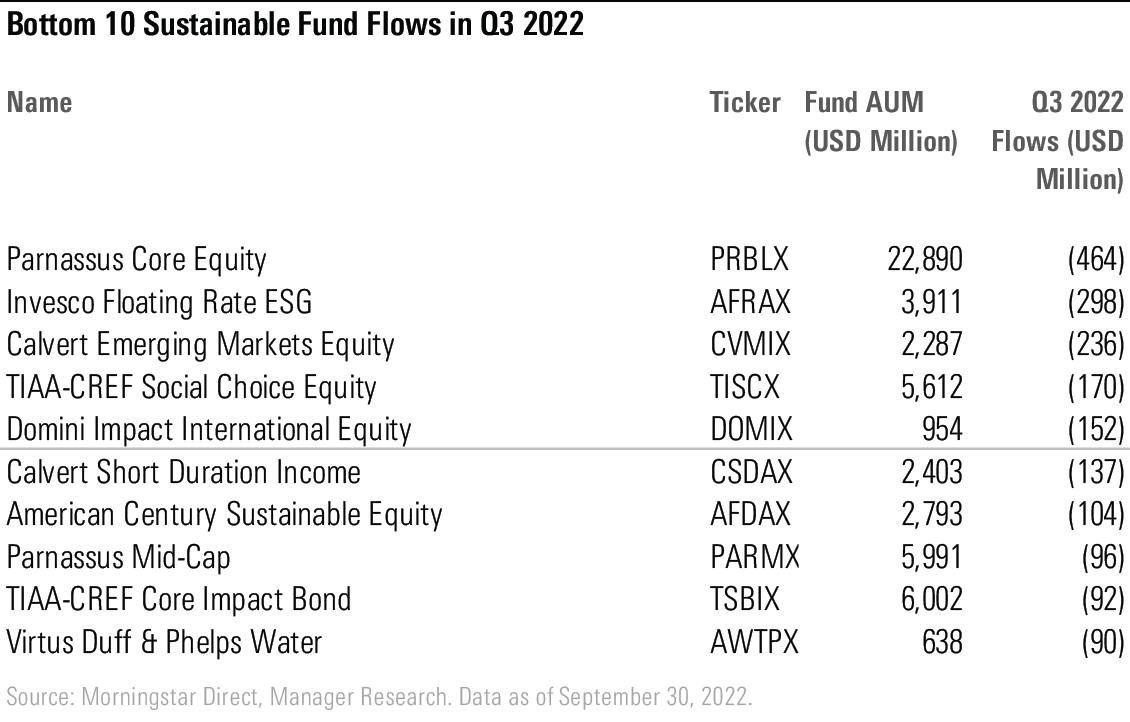
Rising Interest Rates Spooked Bond Investors
Flows into sustainable fixed-income funds were on a steady upward trajectory until the Federal Reserve started raising rates in early 2022. During the third quarter, sustainable bond funds lost $27 million, their first quarter of outflows in more than three years. This paled in comparison with nonsustainable taxable-bond and municipal-bond funds, which surrendered $44 billion during the quarter.
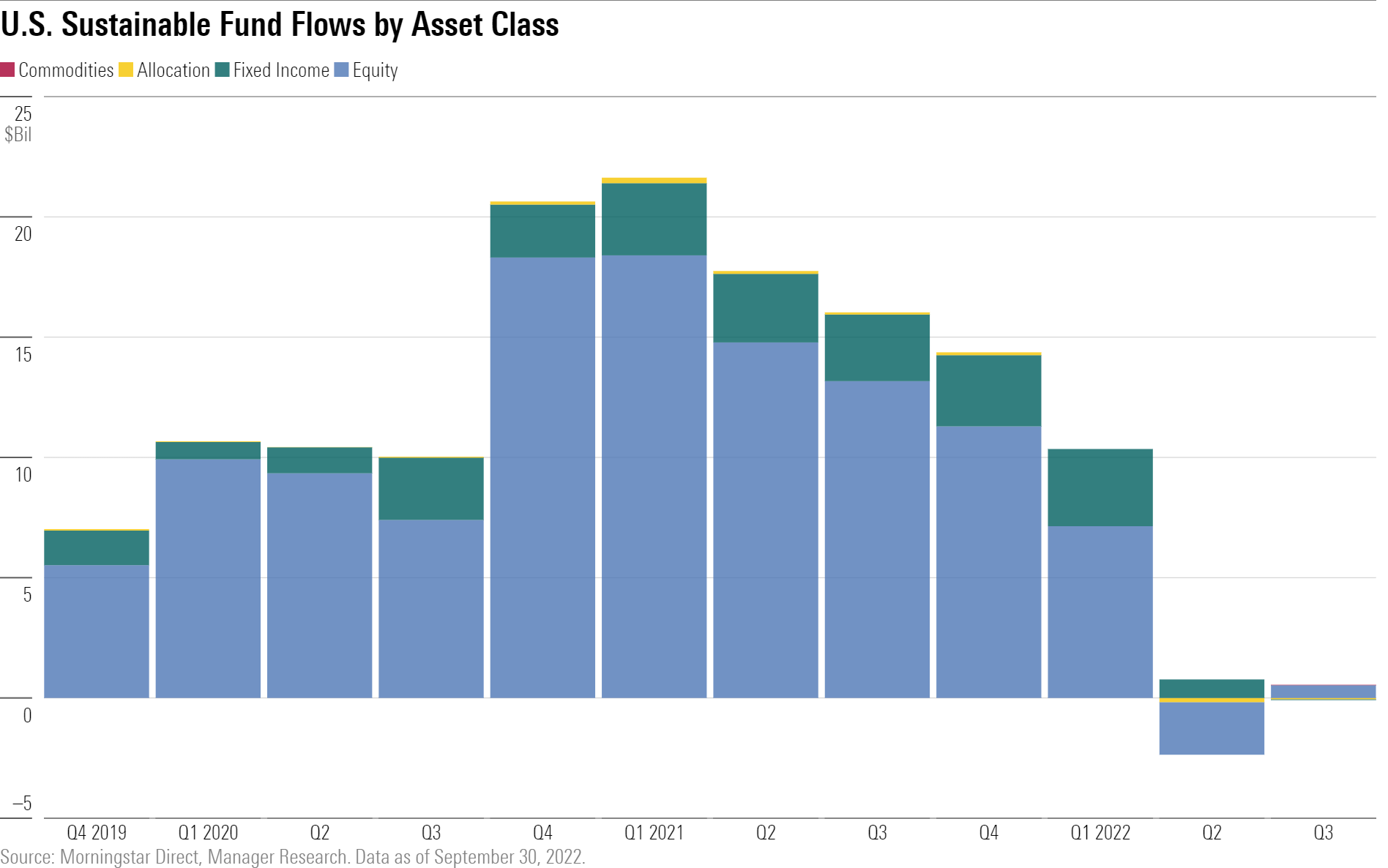
Outflows in September weren’t enough to keep sustainable equity funds down. During 2022′s third quarter, these funds netted $525 million, led by a mix of large-cap domestic and international equity funds. This was their second-weakest quarter in more than three years, reflecting volatility and uncertainty in global markets, but they still held up better than their nonsustainable equity peers, which shed $25 billion during the period.
Assets in U.S. Sustainable Funds Dipped to the Lowest Level Since Early 2021
Despite attracting positive flows in the third quarter, assets in sustainable funds sunk to $272 billion, their fourth consecutive quarterly decline. This represents a 24% drop from the all-time record of $358 billion at the end of 2021. By comparison, assets in the broader U.S. market also peaked at the end of 2021 (at $28 trillion) and slid by 23% to $21.5 trillion at the end of 2022′s third quarter.
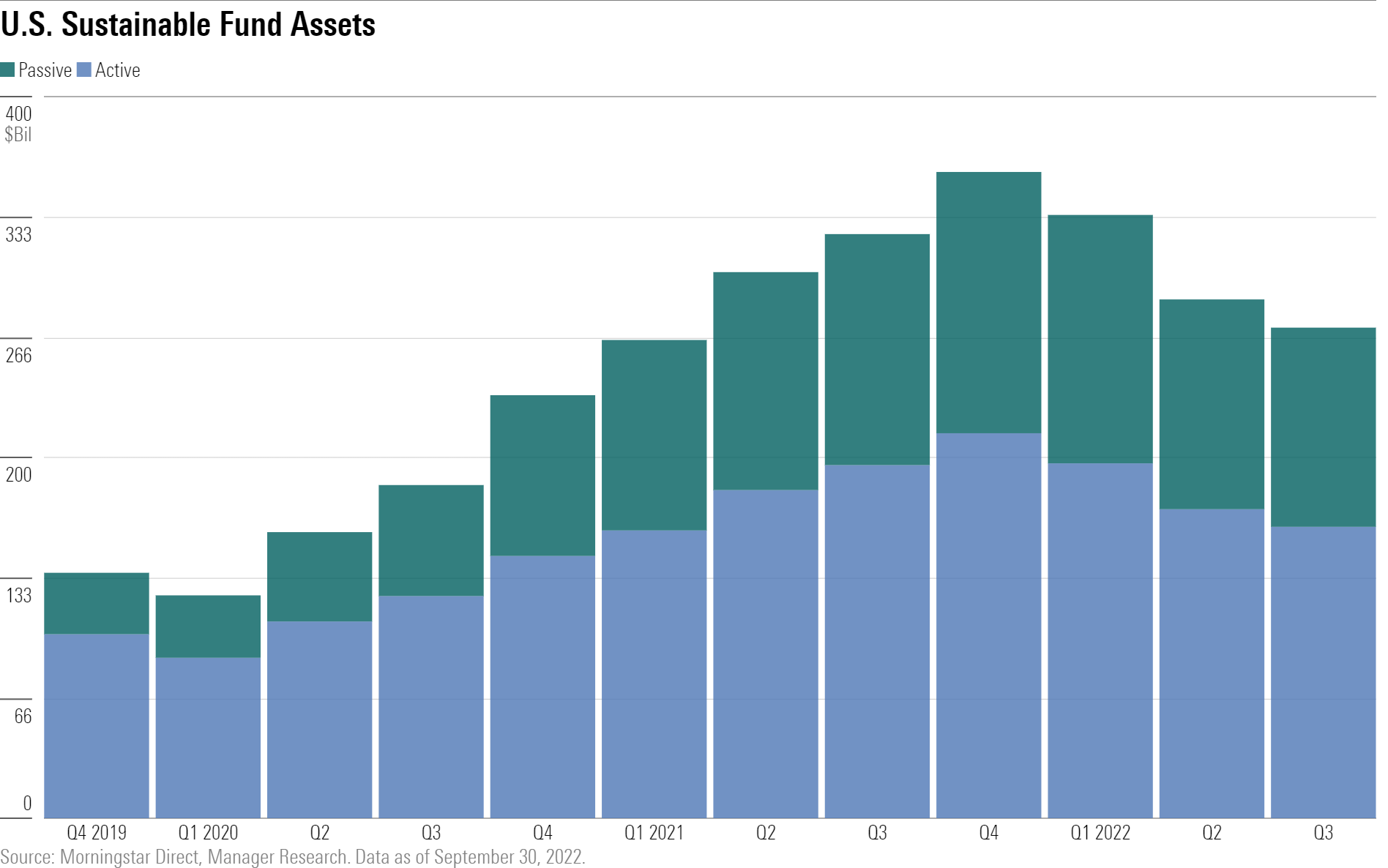
Active Funds Dominated New Sustainable Fund Launches Once Again
Despite increasing investor preference for passive funds, all but one of the 15 sustainable funds launched in the U.S. during 2022′s third quarter are actively managed. On average over the past three years, active funds have accounted for 73% of sustainable fund launches, and this quarter’s 93% exceeded that trend.
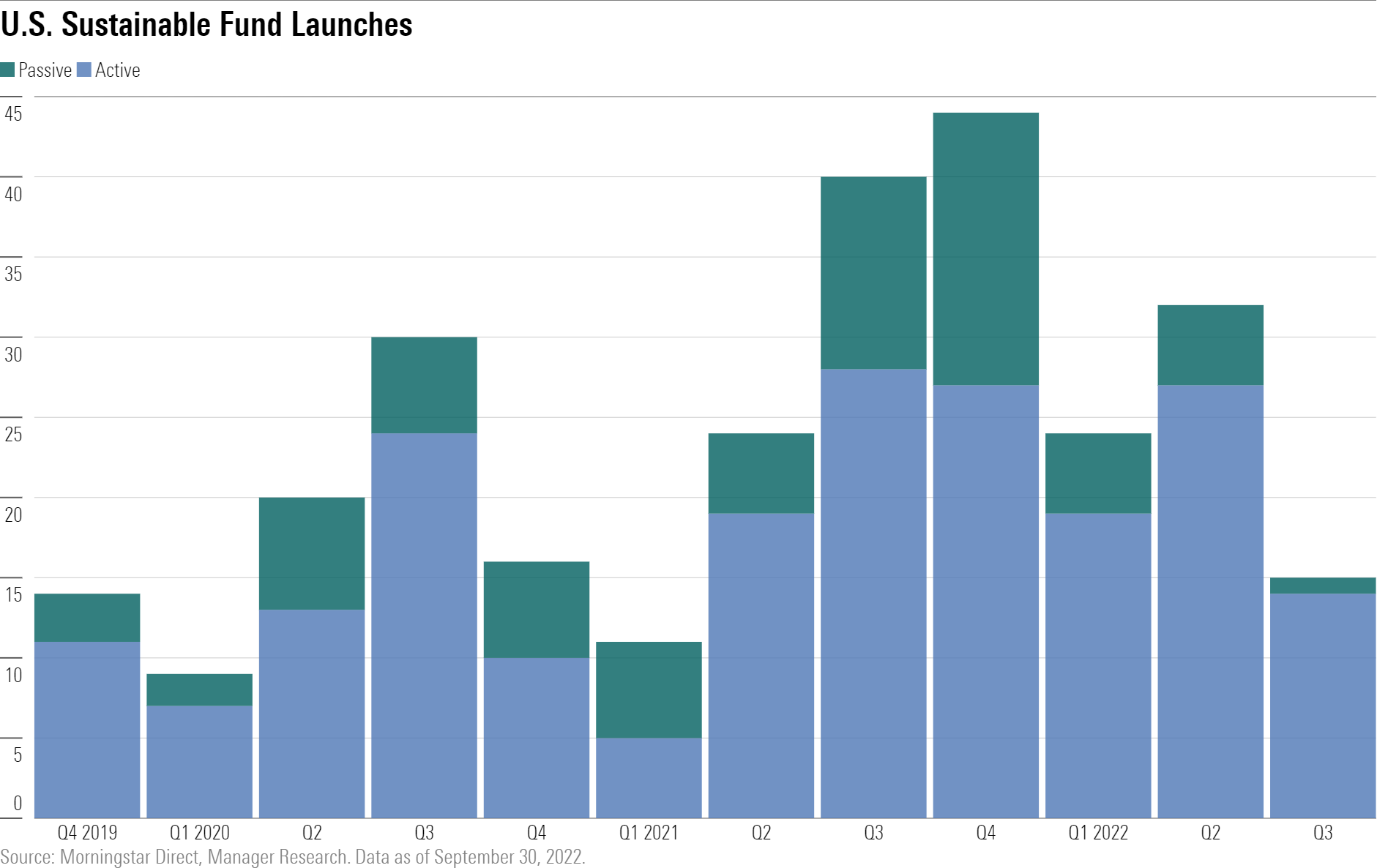
The single new passive offering is Harbor Energy Transition Strategy ETF, an index-based commodities strategy launched in July. The index is composed of futures contracts on physical commodities such as copper, aluminum, nickel, zinc, and platinum, which are associated with the transition to renewable energy sources.
New Sustainable Funds Focused on Impact Themes
The largest new U.S. sustainable fund was AXS Green Alpha ETF, the third sustainable offering from alternatives-focused AXS Investments. This actively managed equity fund targets four pillars of sustainability: renewable energy, wealth distribution, economic “dematerialization” (or increasing the level of economic output from shrinking quantities of inputs), and life cycle supply chain management (reusing functional materials to reduce the strain on geological resources). Some of its top holdings include Vestas Wind Systems, Brookfield Renewable, and JinkoSolar Holding, which have high levels of exposure to the climate action impact theme.
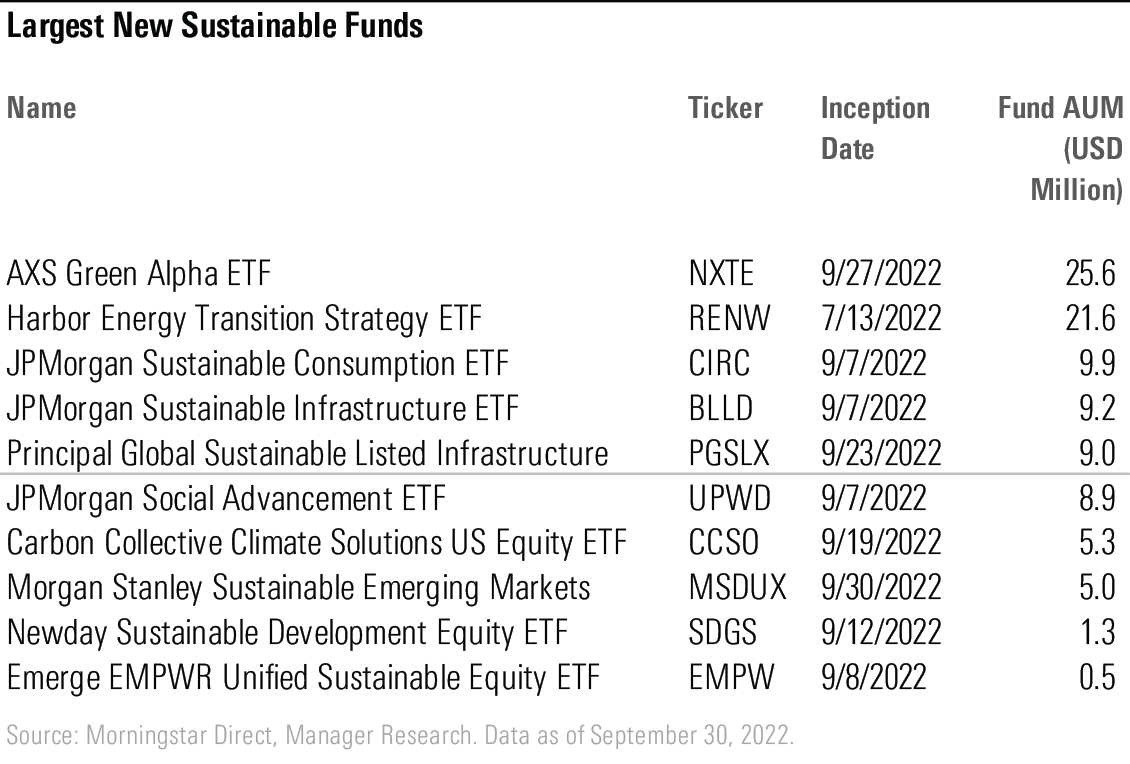
Firms Continued to Repurpose Funds for Sustainable Outcomes
Most of the new options available to investors were launched with sustainable mandates, but firms also occasionally change the investment strategies of existing funds to target sustainable outcomes. Four funds were repurposed to adopt sustainable mandates in the third quarter of 2022.
The largest of these was Delaware Climate Solutions, with $232 million in assets. The fund was previously named Delaware Ivy Energy and invested in companies involved in exploration, production, distribution, or infrastructure related to energy (and/or alternative energy) sources. The fund’s updated focus is on firms involved in reducing and/or sequestering greenhouse gas emissions. It still holds traditional energy companies but prefers those that demonstrate a commitment to decarbonization in line with the Paris Agreement.
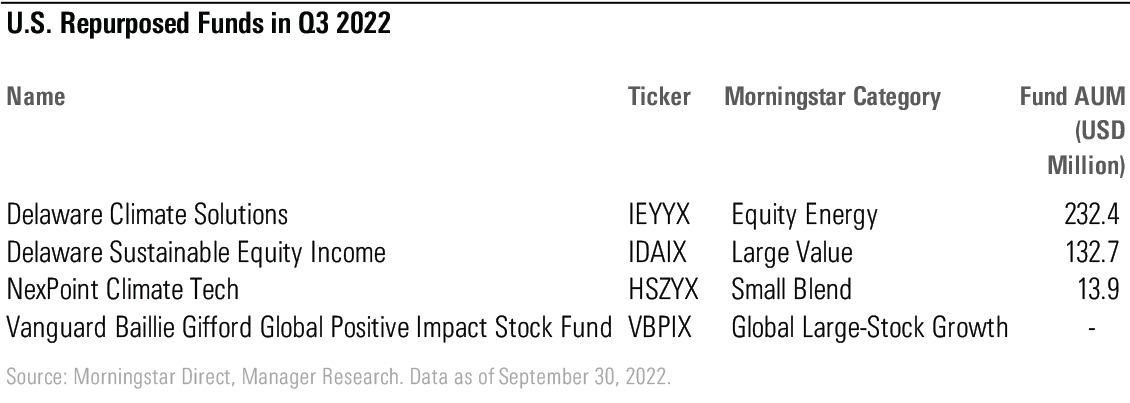
One Firm No Longer Draws Inspiration from ESG Investing
During the third quarter, eight funds from Inspire renounced sustainable investing mandates. As such, they were removed from our sustainable funds universe, although their flows and assets during the period they followed ESG mandates are maintained for recordkeeping purposes. The announcement came in August, even though two of these funds—Inspire 100 ETF and Inspire Global Hope ETF—adopted sustainable mandates only in March of 2022.
In his statement, Inspire’s CEO claims that ESG investing “has become weaponized” by the political left, apparently the firm’s key rationale for abandoning the investment strategy. Yet the most recent prospectus (dated Oct. 14, 2022) still indicates a focus on environmental issues such as air quality, greenhouse gas emissions, and ecological impacts (including biodiversity loss, habitat destruction, and deforestation).
This follows an emerging trend of fund managers launching explicitly “anti-ESG” strategies. Though we do not systematically track these strategies, one example is the Constrained Capital ESG Orphans ETF ORFN (launched in May 2022), which invests in companies it deems to be forsaken by ESG investors (and therefore undervalued in the market).
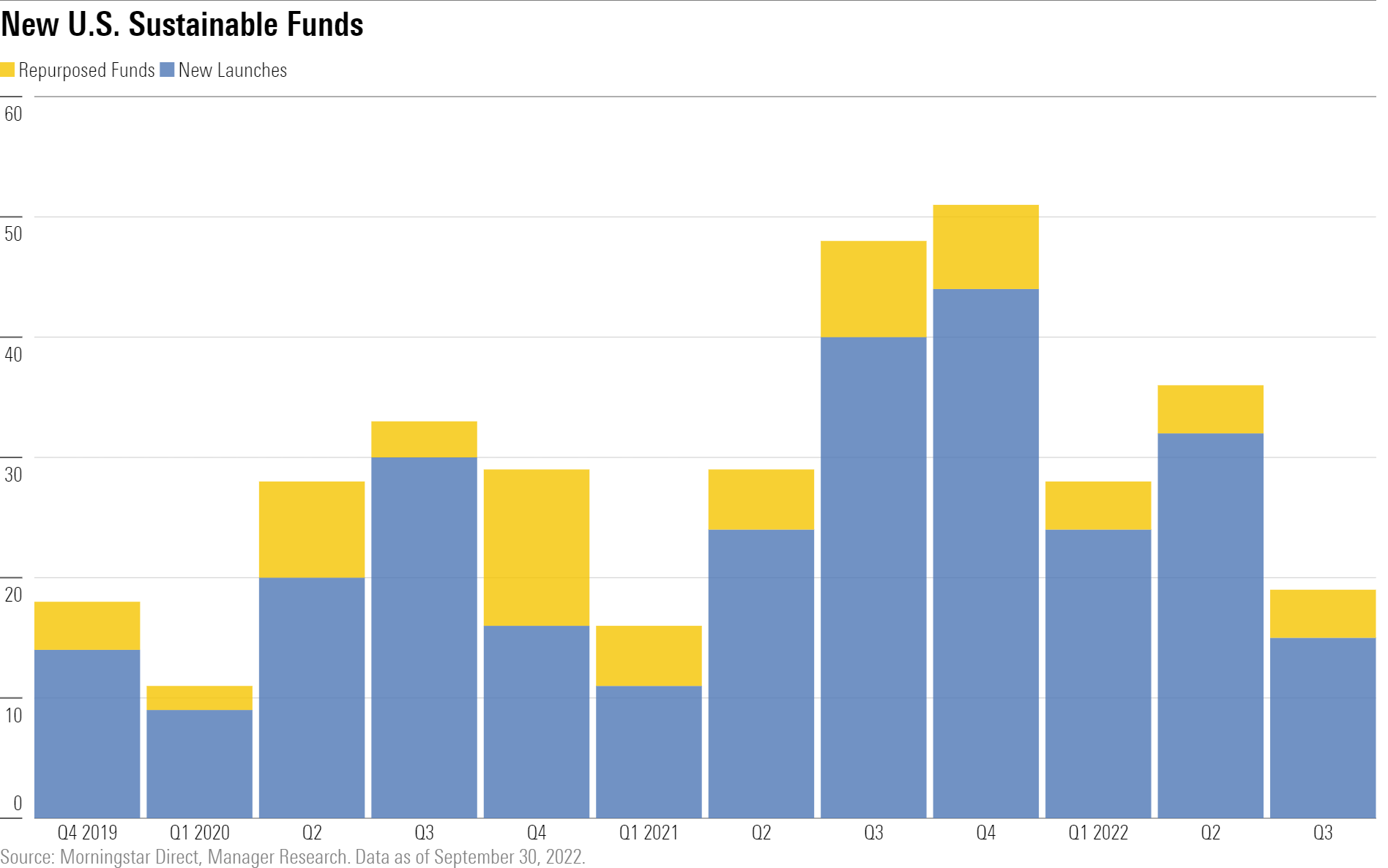
The new offerings and repurposed funds brought the total number of sustainable open-end funds and ETFs in the U.S. to 580 at the end of the quarter.
For a global look at sustainable fund flows for the third quarter, read the Morningstar Global Sustainable Fund Flows Report.
Note: The U.S. sustainable fund universe encompasses open-end and exchange-traded funds for which sustainable investing is central to the overall investment process, based on prospectus filings. In August 2022, Morningstar enhanced its Sustainable Attributes Framework, which is used to build the U.S. sustainable fund universe. We have reflected the related changes in this report. After accounting for new sustainable funds and those which no longer qualify, the third-quarter universe of 580 U.S. sustainable funds is eight fewer than what we reported in the second-quarter report. For continuity and comparability purposes, we have revised the universe and related data for 2022′s first and second quarters.
The author or authors do not own shares in any securities mentioned in this article. Find out about Morningstar’s editorial policies.

/s3.amazonaws.com/arc-authors/morningstar/987376c2-20a0-406b-b3ec-df530324b39c.jpg)
/cloudfront-us-east-1.images.arcpublishing.com/morningstar/RFJBWBYYTARXBNOTU6VL4VSE4Q.png)
/cloudfront-us-east-1.images.arcpublishing.com/morningstar/WYB37DY4NVDTVNZTSBDENH3GMI.png)
/cloudfront-us-east-1.images.arcpublishing.com/morningstar/JPJHXR5CGSNR4LKQF5ZKLCCVYQ.png)
:quality(80)/s3.amazonaws.com/arc-authors/morningstar/987376c2-20a0-406b-b3ec-df530324b39c.jpg)